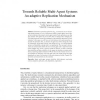Free Online Productivity Tools
i2Speak
i2Symbol
i2OCR
iTex2Img
iWeb2Print
iWeb2Shot
i2Type
iPdf2Split
iPdf2Merge
i2Bopomofo
i2Arabic
i2Style
i2Image
i2PDF
iLatex2Rtf
Sci2ools
MAGS
2010
2010
Towards reliable multi-agent systems: An adaptive replication mechanism
Abstract. Distributed cooperative applications (e.g., e-commerce) are now increasingly being designed as a set of autonomous entities, named agents, which interact and coordinate (thus named a multi-agent system). Such applications are often very dynamic: new agents can join or leave, they can change roles, strategies, etc. This high dynamicity creates new challenges to the traditional approaches of faulttolerance. In this paper, we will focus on crash failures, with usual preventive approaches by replication. But, as criticality of agents may evolve during the course of computation and problem solving, static design (as, e.g., for critical database servers, well identified at design time) is not appropriate. Thus we need to dynamically and automatically identify the most critical agents and to adapt their replication strategies (e.g., active or passive, number of replicas), in order to maximize their reliability and their availability. In this paper, we describe a prototype architect...
| Added | 29 Jan 2011 |
| Updated | 29 Jan 2011 |
| Type | Journal |
| Year | 2010 |
| Where | MAGS |
| Authors | Zahia Guessoum, Jean-Pierre Briot, Nora Faci, Olivier Marin |
Comments (0)

